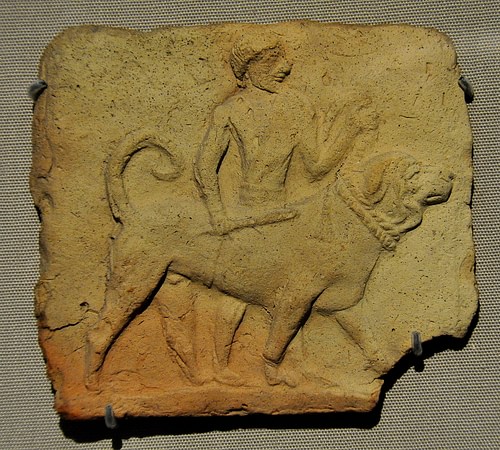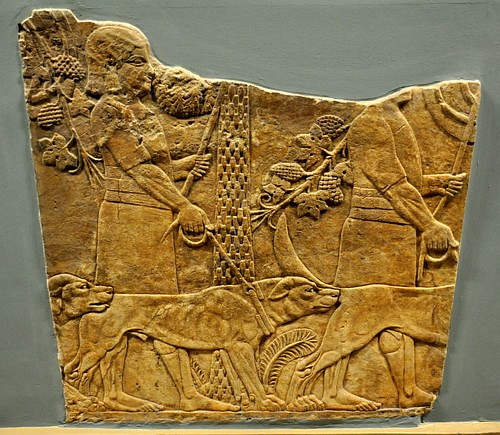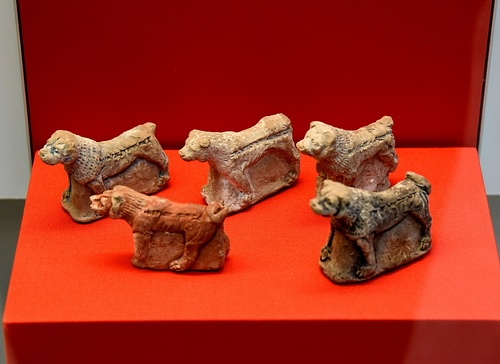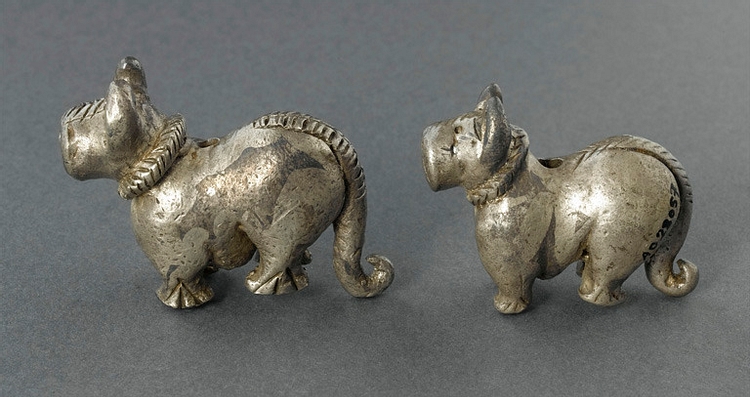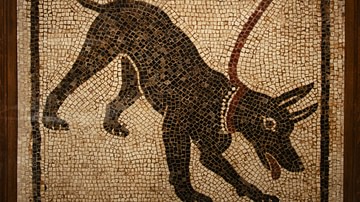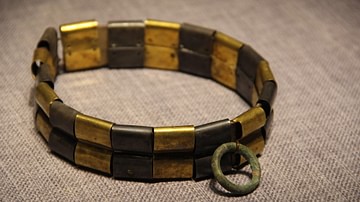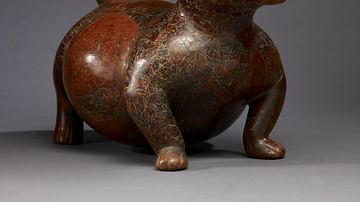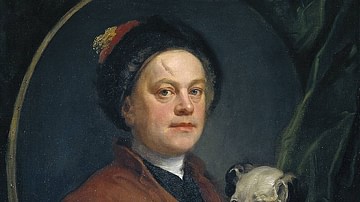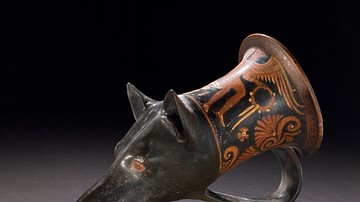Among the many contributions to world culture credited to Mesopotamia is an object so familiar to people in the modern world that few pause to consider its origin: the dog collar. Throughout the ancient world, from China to Rome, dogs are depicted in works of art on a leash attached to a collar.
The dog collar was so integral an aspect of the people's daily lives that even the dogs of the gods are seen in collar and leash; a relationship first evident in art from ancient Mesopotamia. In the same way that scholars debate the origin of the dog and its first domestication, it is difficult to say with certainty that the people of Mesopotamia were the first to invent the collar. It is probable, even quite likely, that the collar – like people's relationship with dogs themselves – developed independently in many different regions at different times. Even so, as far as the collar's depiction in ancient art is concerned, the earliest come from Mesopotamia.
Dogs were greatly esteemed in Mesopotamia as protectors, healers, and companions of the gods. The healing goddess Gula was always depicted with a dog, as was Inanna, one of the most – if not the most – popular deities in the Mesopotamian pantheon. Images, amulets, statuary, and engravings of dogs were regularly produced for a variety of reasons, and in most of these, the dog is seen wearing a collar. In the modern day, then, the simple act of a dog's owner putting collar and leash on his or her friend is a repetition of a practice going back thousands of years to another time and place. Although the dog collar of the present is made of different materials, the basic design remains unchanged and, it seems, the essential relationship between people and their dogs does as well.
This relationship is well established in Mesopotamia from as early as 3300 BCE in the southern area known as Sumer. Orientalist Samuel Noah Kramer, in his book History Begins at Sumer, examines 39 "firsts" in history from the region, among which are the first schools, the first proverbs and sayings, the first messiahs, the first Noah and the Flood stories, the first love song, the first aquarium, the first legal precedents in court cases, the first tale of a dying and resurrected god, the first funeral chants, first biblical parallels, and first moral ideas.
The Sumerians also essentially invented time in that their sexagesimal system of counting (a system based on the number 60) created the 60-second minute and the 60-minute hour. They also divided the night and day into periods of 12 hours, set a limit on a 'work day' with a time for beginning and ending, and established the concept of 'days off' for holidays. Although Kramer does not list the dog collar among his "firsts," and there is no official record establishing the invention, it is evident from artistic and literary works that the Sumerians valued dogs and used collars quite early in their history.
Dogs in Literature
Long before the famous Aesop of Greece (c. 620-564 BCE) wrote his fables, the Sumerians were already well-versed in the genre. Kramer points out how the dog is featured most prominently in these stories, writing, "the dog comes first, being referred to in some 83 proverbs and fables" (124). Aesop, in fact (or the unknown compiler we know by that name) probably collected earlier Greek and Sumerian fables rather than composing anything original himself. Aesop's fame rests entirely on the efforts of 15th-century CE printers to find material they could publish through the new invention of the printing press. The first English edition of Aesop's Fables was brought out by William Caxton in 1484 CE to provide the public with inspiring reading material. The Sumerians had already accomplished this goal some 3,000 years earlier through stories such as Why the Dog is Subservient to Man and The Show Dog.
In the former story, a dog barks at a lion who is approaching a village and is struck by it while the fox cowers nearby pretending to be frightened. The fox slyly declares that, if one pretends to be humble and show fear, one can walk easily with lions. The dog in the story is the hero, however, because he shows his true intentions in protecting the people from the lion.
In The Show Dog, a purebred has puppies and complains to her mongrel friend that they will never win a prize because of their sire's lineage. The mongrel responds, "Whether I have fawn-colored puppies or whether I have brindled ones, I love my young." The show dog is thus presented as shallow in that she only values her puppies by the prestige they can bring her while the mongrel, the common dog, loves her young unconditionally.
Many of the best-known fables attributed to Aesop are actually Sumerian in origin, including the famous maxim of the "dog in the manger" referring to someone who refuses to enjoy an experience but also will not allow any others to enjoy it. Although dog collars are not specifically mentioned in these fables, it is assumed they were in use – especially if there were dog shows as the above tale suggests – and they are clearly represented in art.
Collars & Amulets
The dog collar features in almost every depiction of dogs in Mesopotamian art. Inscriptions from the Ur III Period (2047-1750 BCE) describe a caravan coming into the city which includes dogs and their handlers. Scholar Paul Kriwaczek notes how "images show large mastiff-like creatures; the food they consumed suggests that they were nearly as heavy as the men who looked after them" (144). These dogs were restrained by thick collars and leashes, most likely of leather, though how they were made or ornamented cannot be discerned from the images.
There are other images, however, which present a clearer picture. A golden dog pendant, currently at the Museum of Fine Arts, Boston, USA, dates from c. 3300 BCE and was found at the Sumerian city of Uruk. It is a figure of a dog with a wide collar that seems decorated with stripes. The dog appears to be of the Saluki breed, curly tail and tall ears, which is unsurprising since the Saluki is attested to in Mesopotamia as a popular breed in that period. A cylinder seal from c. 3000 BCE, found near Nineveh, clearly shows a Saluki and the intimate nature of such seals suggests the dog's importance.
The small gold amulet would have represented a dog of the upper class in the city whose owner most likely wore it for protection. Dogs were associated with Gula, the goddess of healing, and were often invoked through statuettes, amulets, and figurines for protection from supernatural, or natural, threats.
The Nimrud Dogs
Among the best examples of this practice are the famous figures known as the Nimrud Dogs from the ancient city of Kalhu (known since the 19th century as Nimrud) in Mesopotamia. These are five dog figurines discovered in 1951-1952 CE by the archaeologist Max Mallowan (husband of famed mystery writer Agatha Christie). These dog statuettes represent the Mesopotamian concept of magic and magical protection. The Mesopotamians believed that people were co-workers with the gods to maintain order against the forces of chaos. Humans took care of the tasks the gods had no time for, and in return, the gods gave them all they needed in life.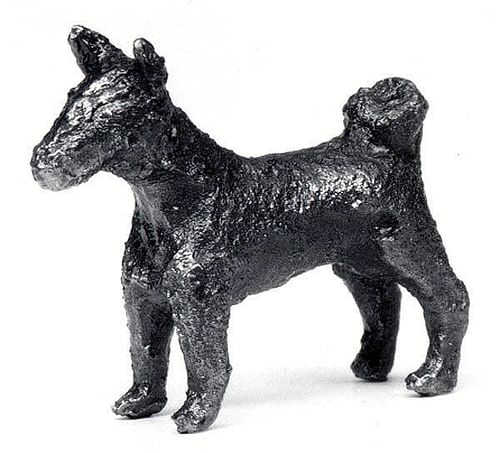
Scholar Jeremy Black notes how statuettes of sitting or standing dogs were often created as protective amulets or statuettes, not associated with any specific god or goddess, which reflected the strong, reliable, protective nature of the dog. The statuettes, such as those Mallowan discovered, were often brightly painted and buried on either side of a doorway to a palace or home to ward off danger.
Protectors, Healers, & Guides
A collection of dogs, corresponding to Black's description, were found at the city of Nineveh in the 19th century CE by the famous archaeologist Austen Henry Layard. The power of such figurines, even if they bear no inscription specifying a deity, came from the gods. The powerful Ishtar (also known as Inanna), goddess of love, passion, war, and fertility was depicted with her dogs held on leashes and, as previously noted, Gula was always shown in the company of her dog and, eventually, the goddess was represented as a seated dog, with a collar, facing a supplicant.
The dog was associated with Gula and healing early on but is clearly attested to during the Ur III Period. It was noted that the dog healed itself through licking its wounds and so its saliva was considered a medicinal property (a belief which has since been proven sound in modern times). In the case of Inanna/Ishtar, her dogs were seen as her companions and protectors and, since she was often invoked for protection, her dogs acquired that same reputation. The natural inclination of dogs to protect their people, of course, gave rise to this aspect of the goddesses' dogs.
Dogs not only healed and protected one in life, however, but also assisted in the transition from earthly existence to the afterlife. Children, especially, were thought to be accompanied in their journey to the land of the dead by the spirits of dogs. These dogs were considered familiar and playful companions to the children who would ease their transition but were also fierce guardians of their charges who would protect them against evil spirits and demons.
Dog Collars & Breeds
This protective aspect of the dog was reflected in the Mesopotamian dog collar. Whatever the earliest collars may have been - most likely rope - before the time of the Ur III Period they are already depicted as thick bands of leather, usually ornamented in some way. They protected the dog's throat while, attached to a leash, providing a safeguard to others from dog aggression.
Judging by the depictions on amulets, inscriptions, and figurines, these collars seem to have had a loop attached, no doubt made of some high-quality material for the top-shelf products and cheaper material for more modest pieces, to which a leash would be attached. Since there were no metal clasps, these early leashes would have been rope or sturdy cloth or even notched sticks (as were used later in ancient Egypt).
Rope collars were still in use during the Ur III Period and no doubt later. A terracotta plaque from Borsippa dated to c. 2000 BCE-1600 BCE shows a man walking beside a large, powerful, dog who wears a rope collar with tassels. The rope seems to be wound around the dog's neck twice and tied at the back with the long end providing a leash and the short one ending in the ornamental tassel. This appears to be similar to the slip-lead commonly used in the present day.
Orientalist Wolfram von Sodden has noted there are three dog breeds positively identified from ancient Mesopotamia, the Greyhound, Dane, and Mastiff, and all three of these breeds would have required a sturdy collar and substantial leash to control. The Saluki, also of Mesopotamian origin, would have needed the same.
The collar not only helped to control and train the dog but also offered protection for the throat, may have included the dog's name, and probably - at least among the upper class - gave some indication of the owner. Mesopotamian cylinder seals - small impression stamps used to authenticate one's identity in writing - frequently depict dogs with collars in the company of their masters, and it is not unreasonable to assume that such seals depict realistic relationships, including the use of the collar.
The Dog Collar as Art
The dog collar in Mesopotamia may have inspired the so-called "dog collar necklace", an expression of high fashion and wealth. Queen Pu'abi of Ur (more accurately known as Queen Pu-Abum, c. 2600 BCE) is the best known royal figure to wear the "dog collar necklace" which became standard jewelry for women during this period. These were made of gold and lapis lazuli but such high-quality metalwork seems to have been only for humans since no actual dog collars of such elevated refinement have yet been found.
There are, however, depictions in art of dogs with intricately designed collars. It is entirely speculative that actual dog collars gave rise to the necklace, but the claim is probable given that dogs, and their collars, were so integral to people's daily lives. All art comes from something, after all, and the necklace may have developed from designs for dog collars.
The Saluki pendant mentioned above seems to have the same design on the collar as the necklace or, at least, is similar. A votive dog statuette from Lagash (dated to between 1894-1866 BCE), presently in the Louvre Museum, also shows an intricately designed collar. This statuette, a beautifully crafted candle-holder, is made of steatite and was dedicated to the goddess Ninisina, one of the older names for Gula when she was a regional deity of the city of Isin. It was given "for the life of Sumu-El, king of Larsa" and crafted by a physician of Lagash probably as a sacrificial gift to the goddess in gratitude for healing.
Another interesting example of the dog collar in Mesopotamian art from the Louvre is the pair of two silver dogs wearing hatched collars from the 3rd-2nd millennium BCE originating in Bactria in Central Asia. The dogs are 1.5 inches (4cm) long with a vertical hole through each. It is thought they may have been worn as pendants on a necklace or could have been ornamental pins to secure a cloak or tunic. The metal stem would have gone through one end of the cloth, then through the hole in the silver dog, and fastened to another end of one's fabric.
The collars of these dogs seem to be ornamented, but the same design extends from their mid-back to half-way down their tails. Perhaps this was the design of the collar or maybe the artist was just interested in a kind of marked symmetry between the front and back of his pieces. Interestingly, two other dog pendants, found at Susa, are similar in design. These date from the 4th millennium BCE, one in gold and the other in silver, both with collars which resemble the dogs of Bactrian design.
Conclusion
Whether the dog collar inspired the now famous "dog collar necklace" cannot be proven, but it is clear that dogs were an important aspect of Mesopotamian life and a frequent subject in painting and sculpture. They are not always mentioned favorably, there were derogatory statements concerning a person being "a dog" then, just as there are now, but the overwhelming evidence is that the dog was highly regarded and played an important role in people's daily lives.
The attention paid to the dogs' collars in art is further evidence of this in both the original collar and the effort of the artist to render it precisely. The uniformity of depictions of collars suggests that these are representations of actual dogs wearing their collars and not artistic license. The dog collar of ancient Mesopotamia reflected the people's belief that, in as much as they could afford it, their canine friend was worth a respectable article of clothing as well as being immortalized in art wearing it.
